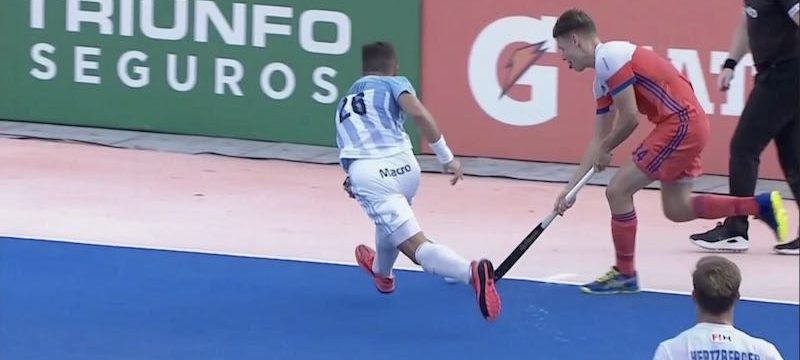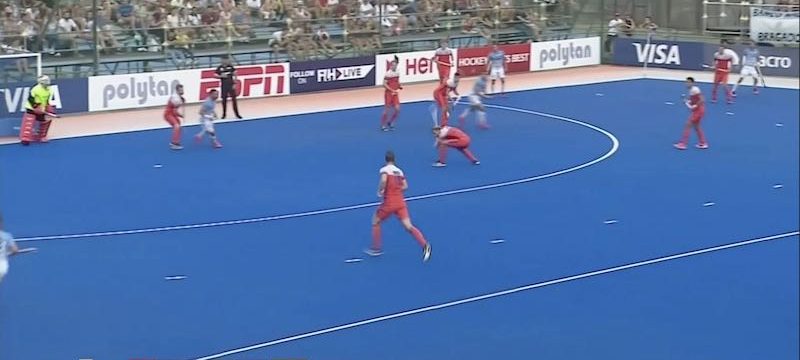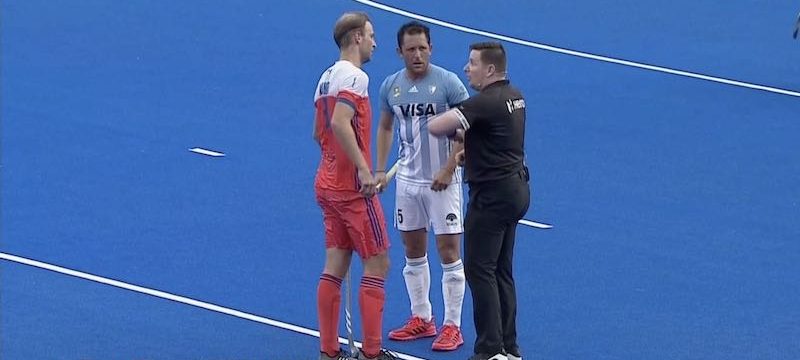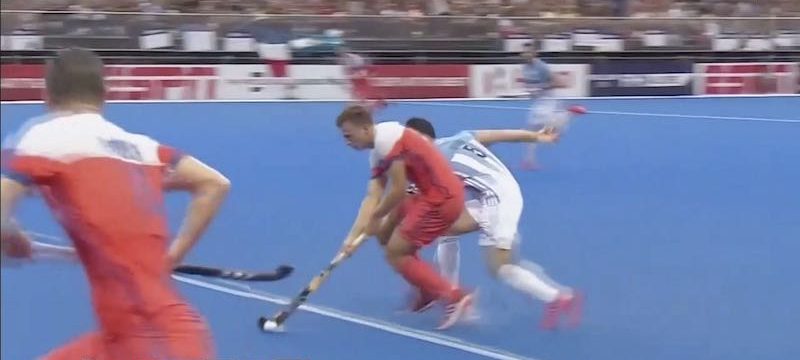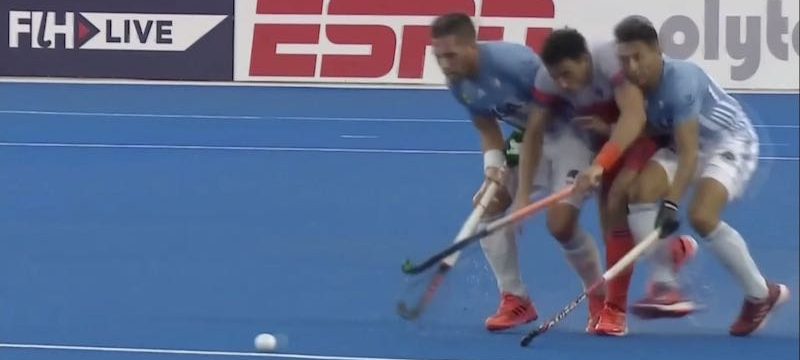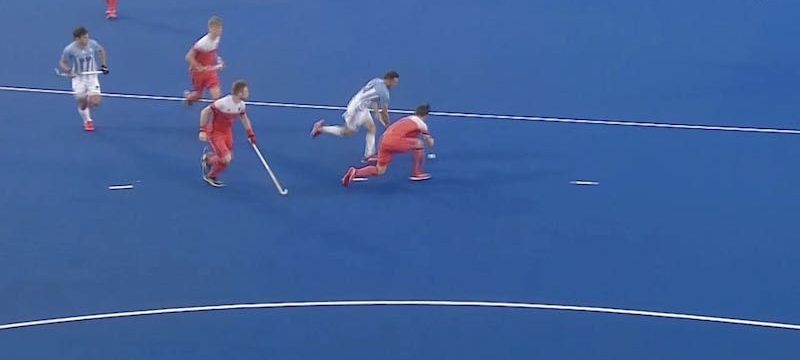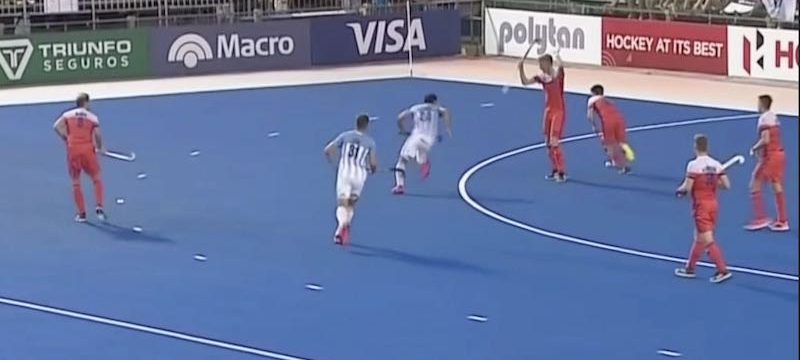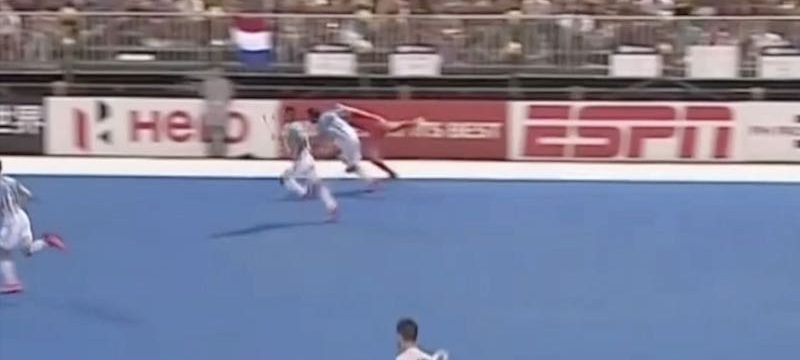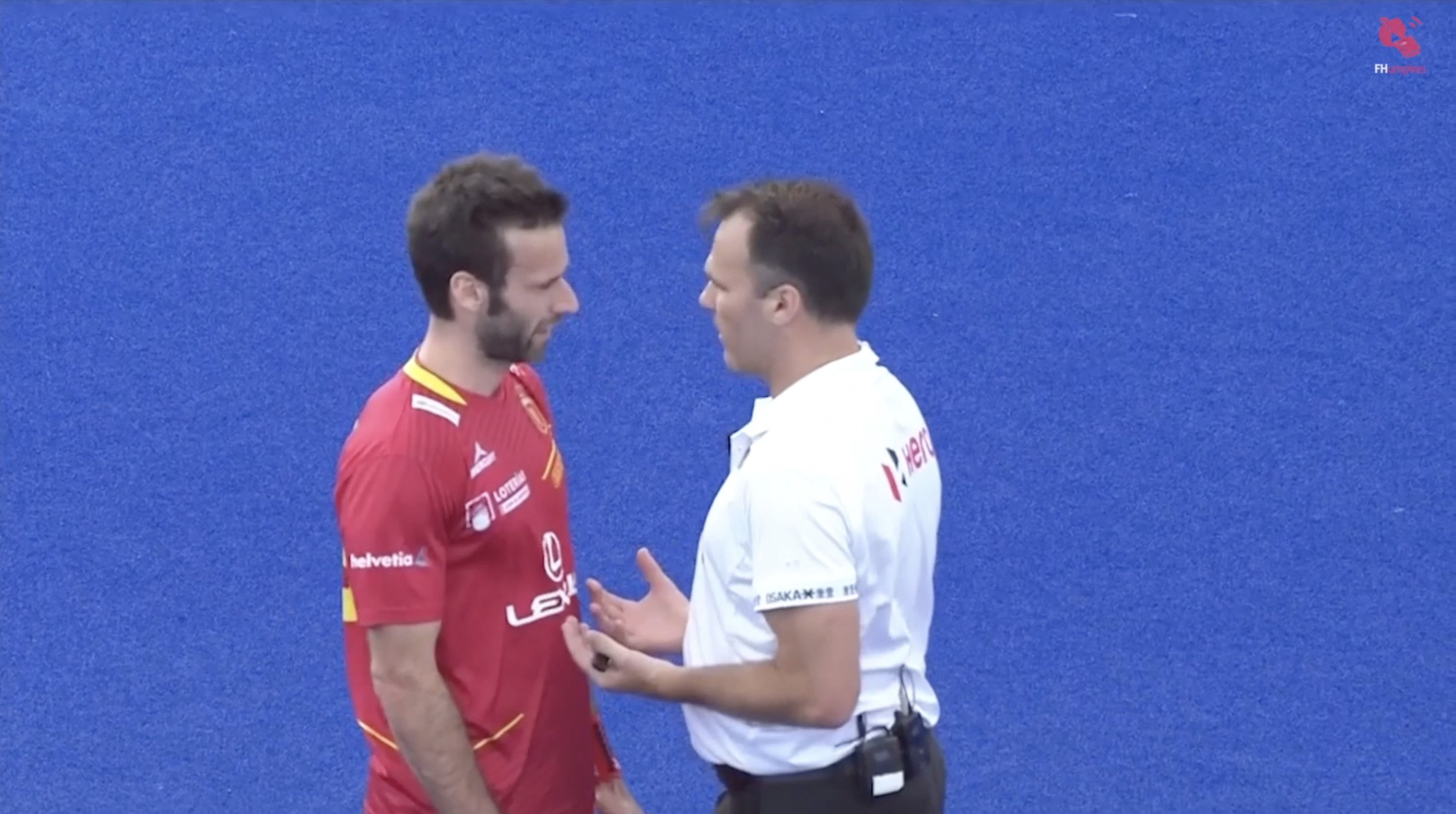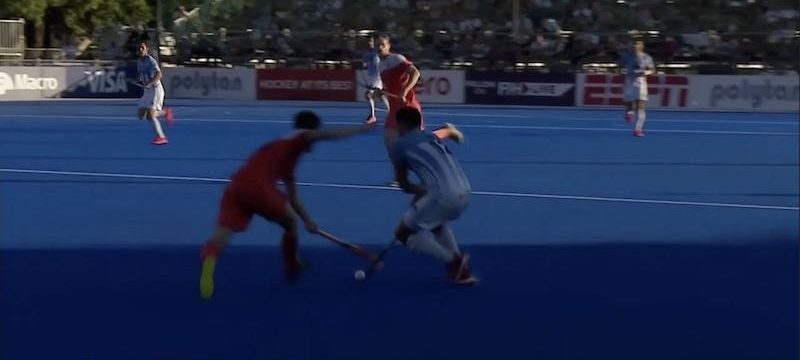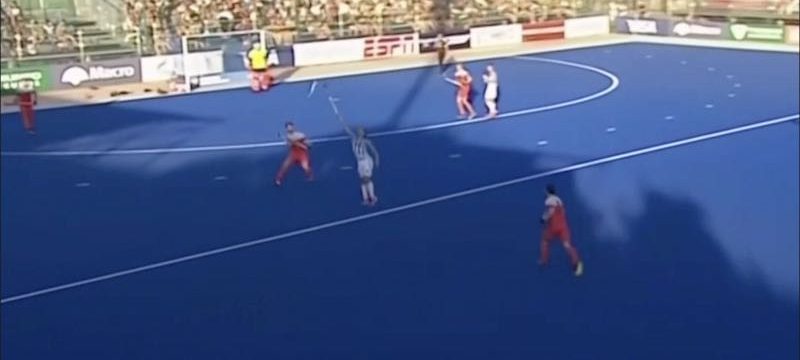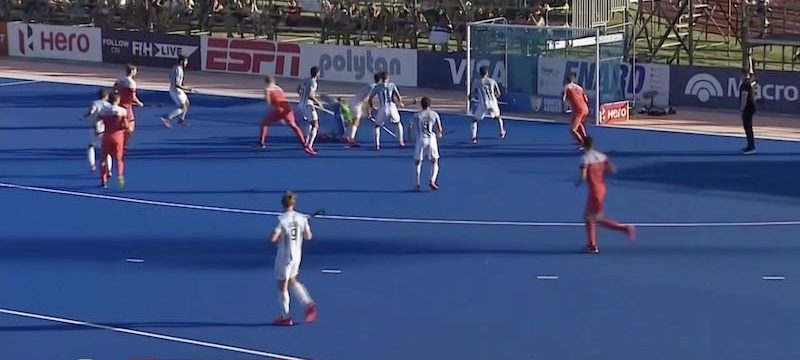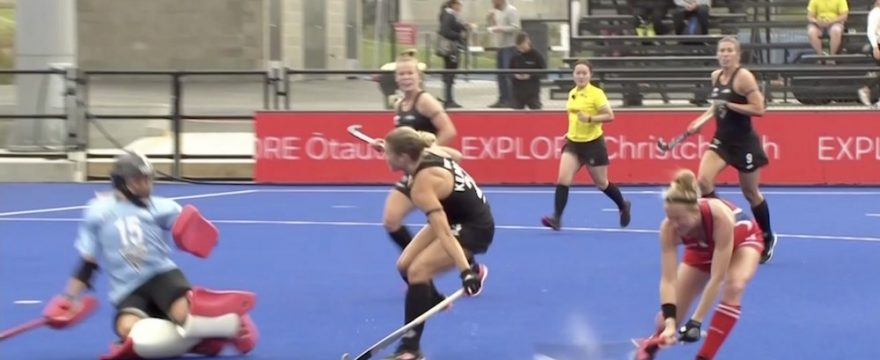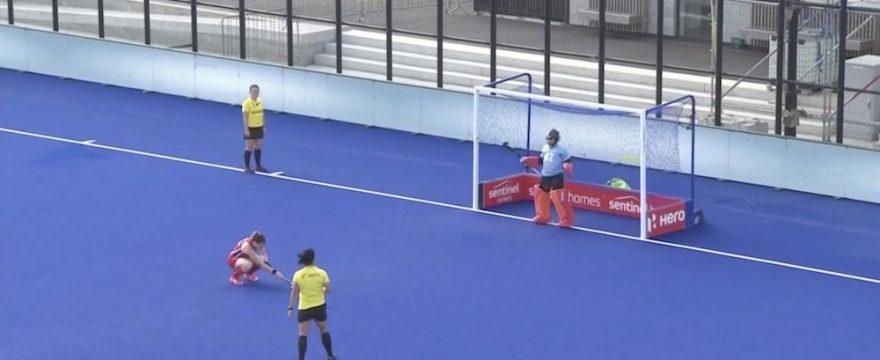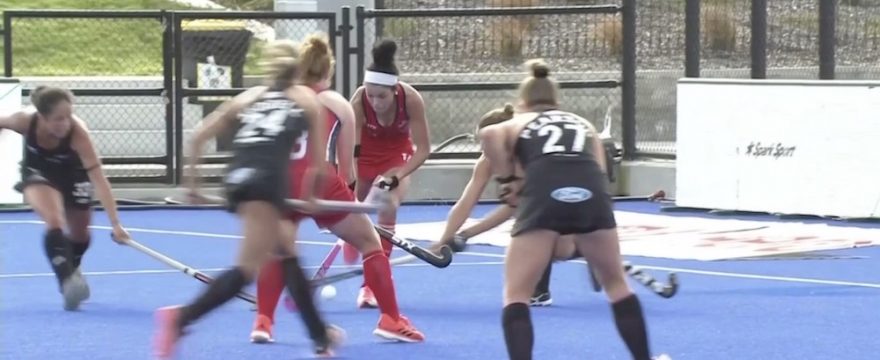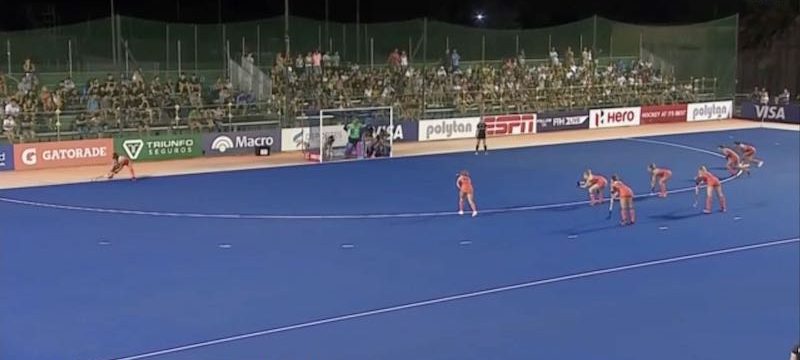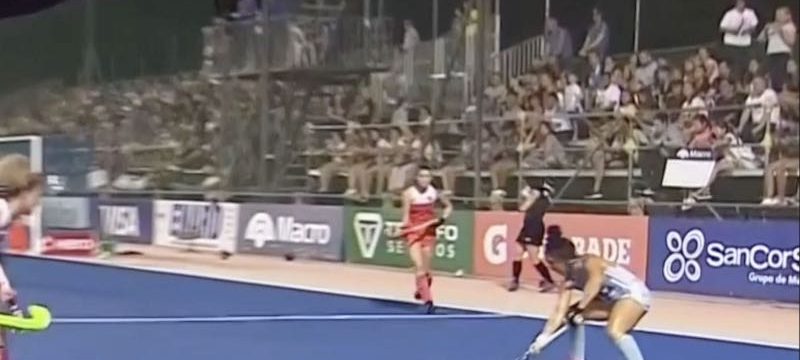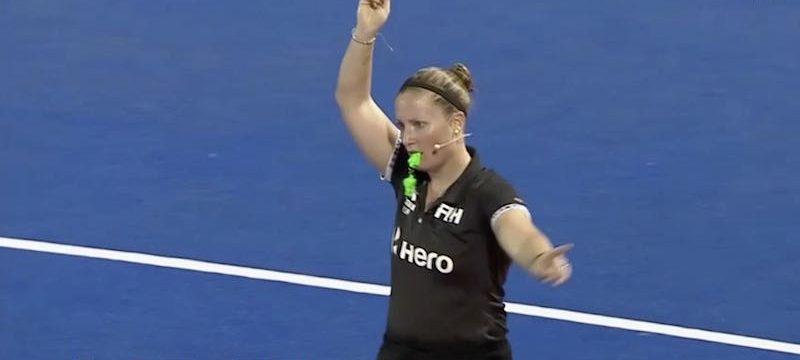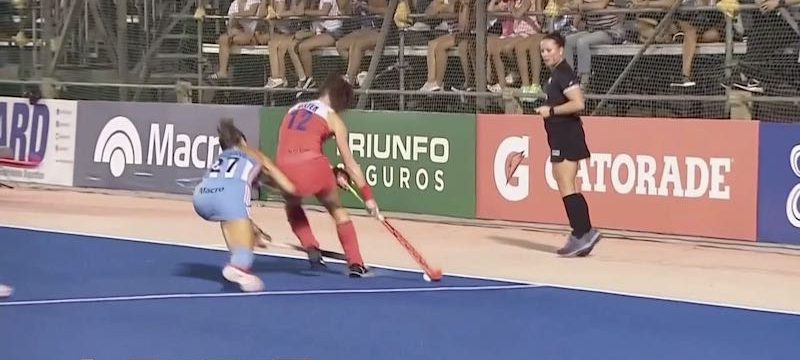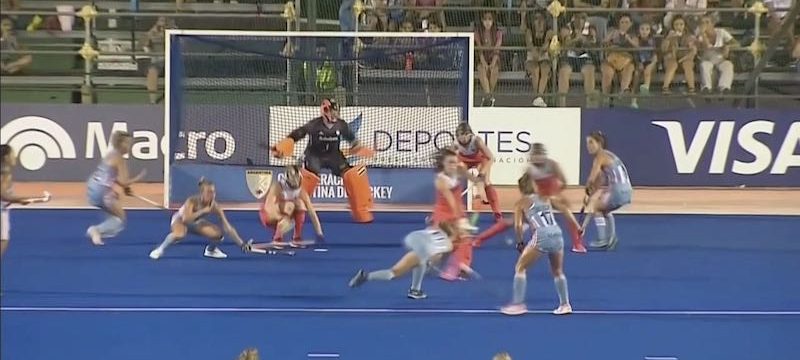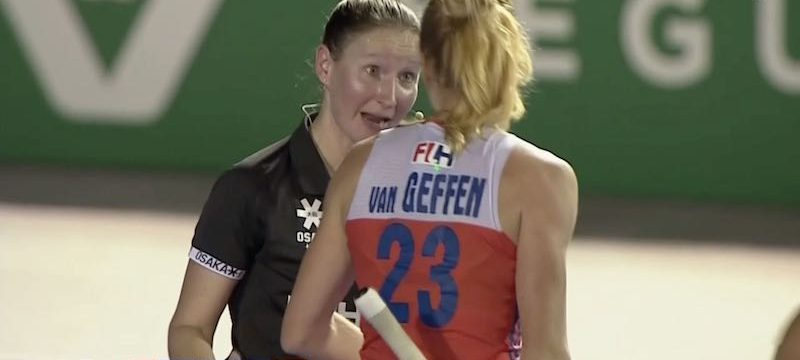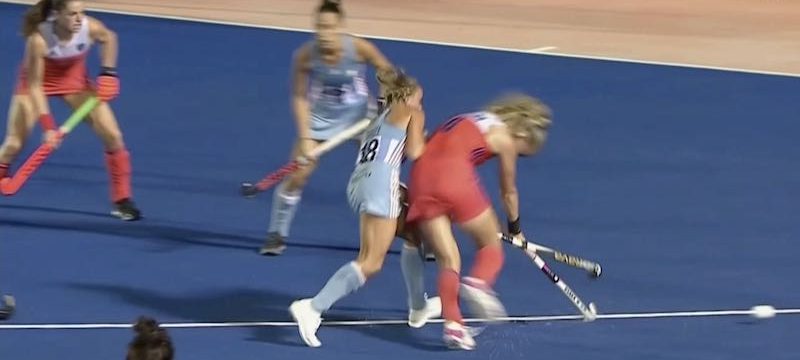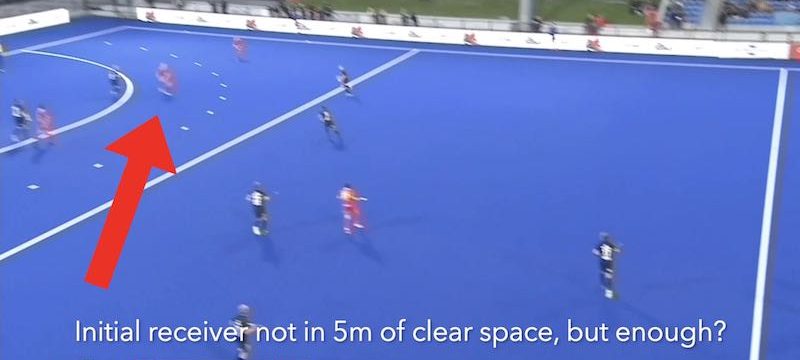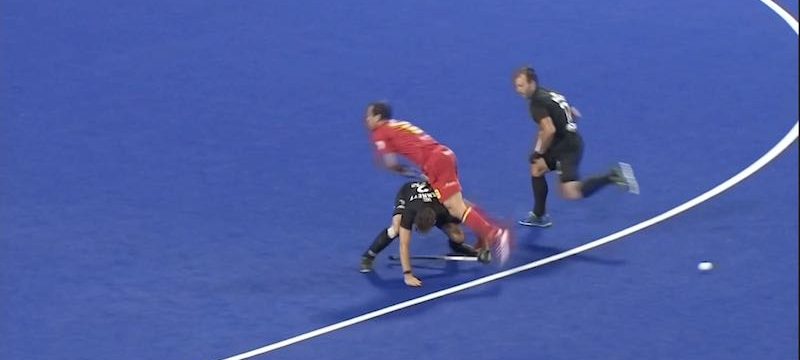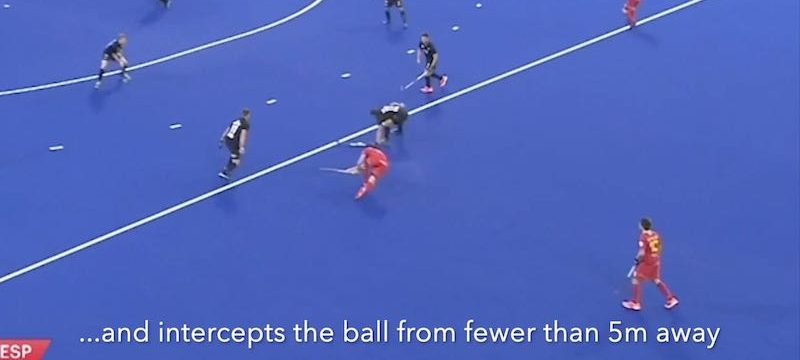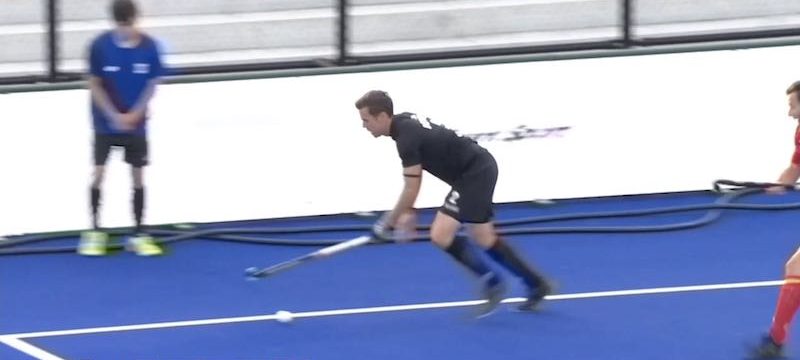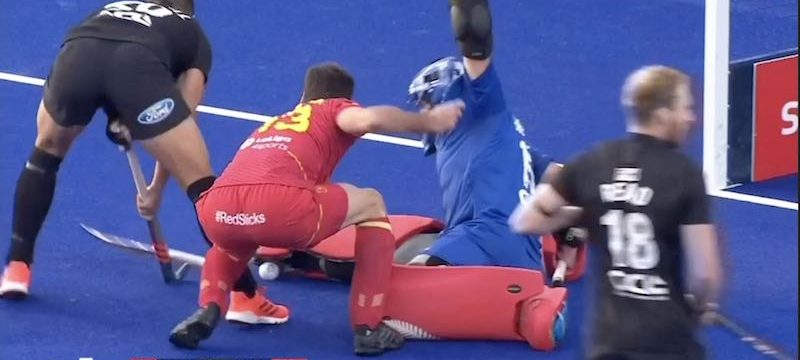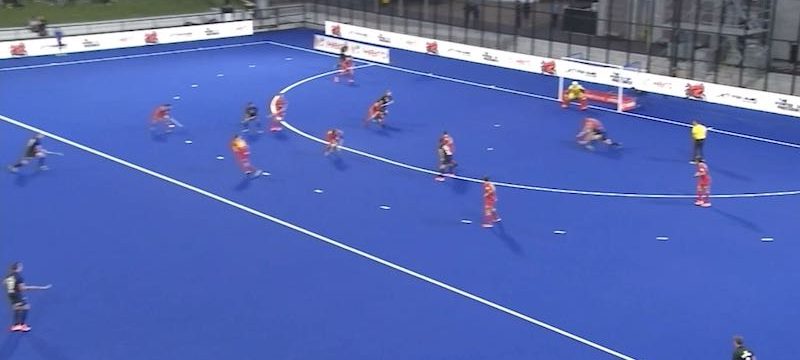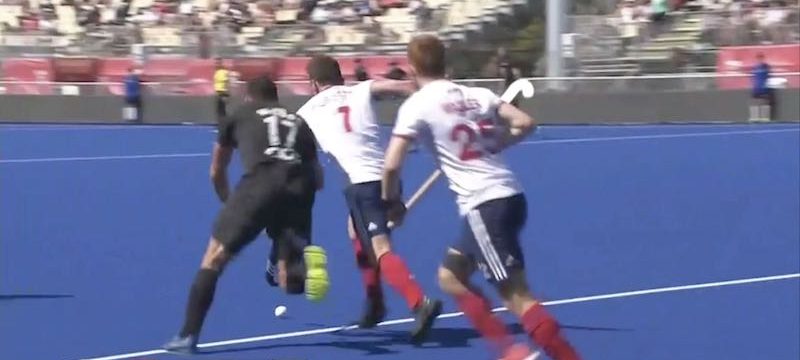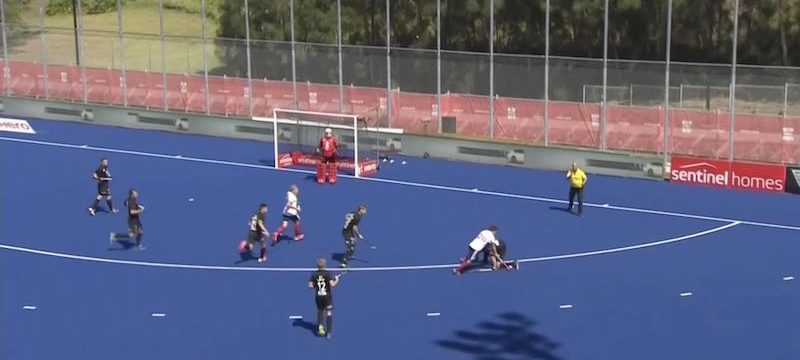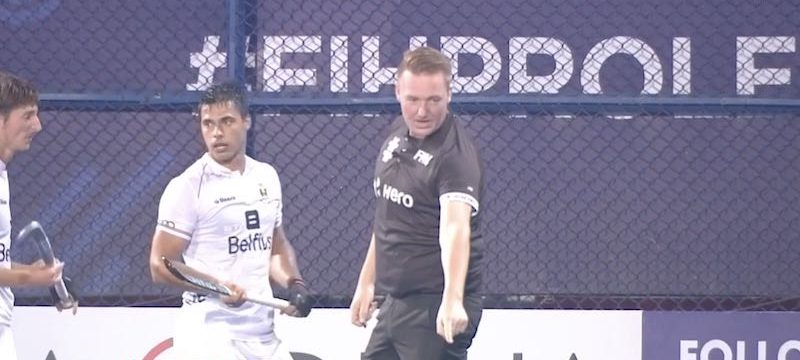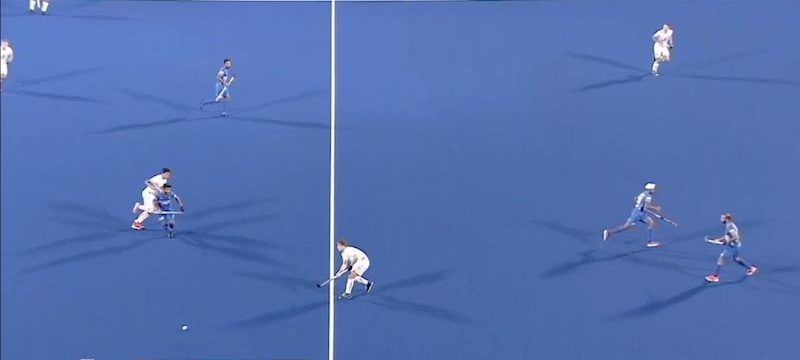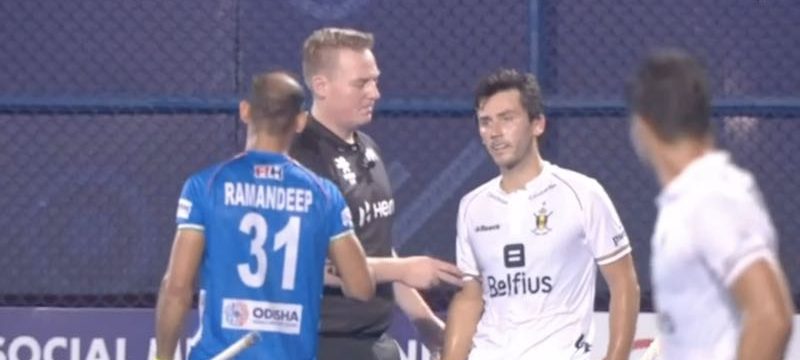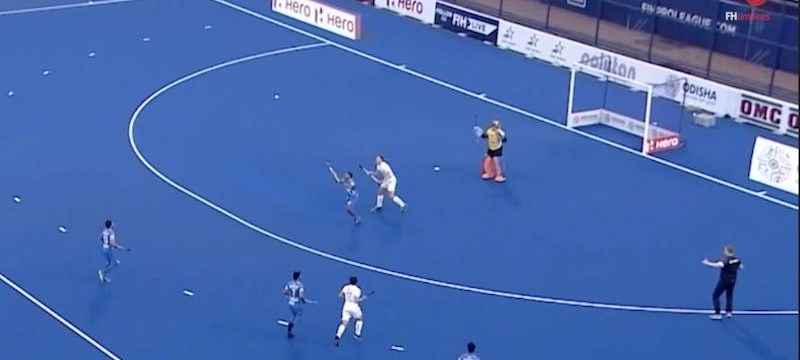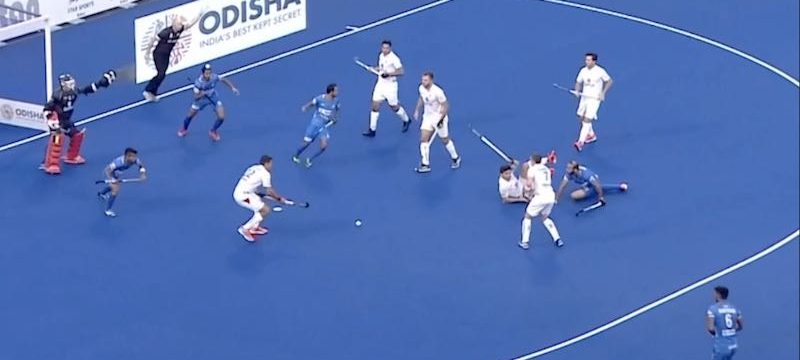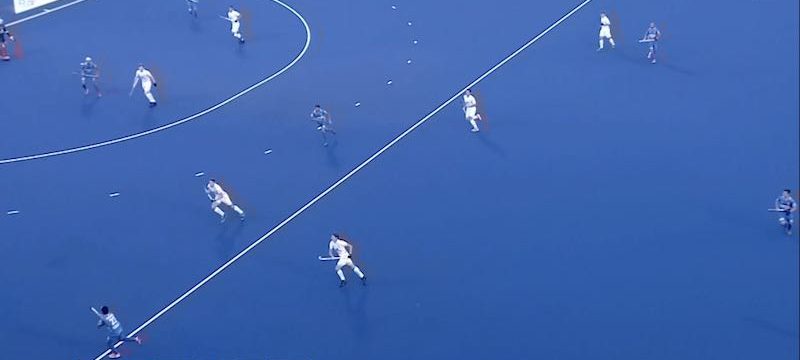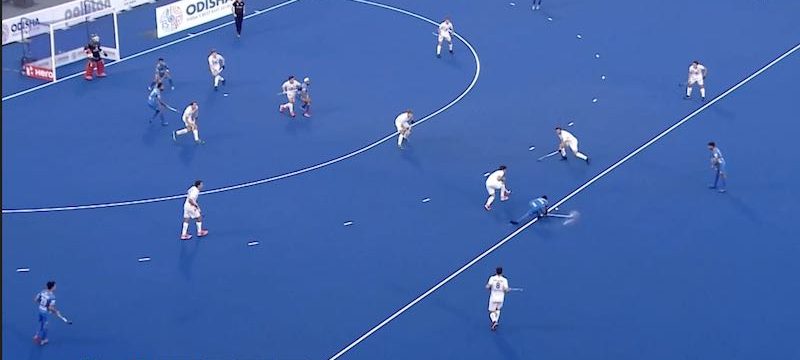Green card given for a tackle occurring before a long advantage is played. Note the timing of the tackle, which is immediately after a turnover is earned with the opposing player in a good space. …
ARGvNED Jab tackle off end line for PC
A jab tackle is sent off the end line, and in the view of the umpire, intentionally. Cues to look for in this situation include the body shape of the defender, who is facing directly off the pitch, …
Continue Reading about ARGvNED Jab tackle off end line for PC →
ARGvNED No danger to teammate
Three incidents happen in quick succession here. A ball hit at pace deflects off a defender’s stick and is only dangerous at that point to his teammate who ducks out of the way, so no foul is awarded. …
ARGvNED Stop time captains
The umpire calls for the captains to have a discussion about physical play off the ball. Early in a game, this is an excellent strategy for player management, inviting the captains to take …
ARGvNED No stick block
A defender claims a stick block occurs on this attacking play. As he’s chasing the ball carrier from behind, the ball carrier changes his direction from cutting to the right to going straight at the …
ARGvNED YC physical breakdown
A yellow card is given for this breakdown tackle after green cards have already been awarded (one to each team), and a warning to the captains for physical play. The level of physical recklessness is …
ARGvNED No stick block 2
A stick block is called against the attacker who appears to move his stick across the ball in a blocking motion. On the reverse angle, you can see more clearly when you focus on the defender’s stick …
ARGvNED No third party obstruction
This situation doesn’t result in a third party obstruction as the defender wasn’t within playing distance, preferring to take a more oblique angle to channel the ball carrier into his far corner. …
ARGvNED YC 10′ for dangerous tackle
A breakdown foul occurs on the sideline on which the umpire plays advantage. The ball enters the circle, and the ball is then sent intentionally off the end line. The foul is dangerous and physical, …
Continue Reading about ARGvNED YC 10′ for dangerous tackle →
NZLvESP YC after advantage for trip behind play
A defender commits a great block tackle and the dispossessed attacker goes over his back. As the attacker is getting up, the defender trips him with his stick and puts him back down again, which is …
Continue Reading about NZLvESP YC after advantage for trip behind play →
NZLvESP Two breakdown stick tackles for GC
A cynical breakdown of play with two consecutive stick obstructions in the double-team leads to a green card. To access this content, you must purchase FHU3T Green, FHU3T Green 365, FHU3T …
Continue Reading about NZLvESP Two breakdown stick tackles for GC →
NZLvESP Player management
In fiery, physical matchups where tempers can really get out of control, player management is a crucial part of both your skillset and your #thirdteam match plan. Adam Kearns shows some of his …
ARGvNED GC breakdown stick obstruction
A long pursuit by a defender leads to two breakdown tackles and one green card. To access this content, you must purchase FHU3T Green, FHU3T Green 365, FHU3T Yellow 365 or FHU3T Yellow. …
Continue Reading about ARGvNED GC breakdown stick obstruction →
ARGvNED Aerial no control
An aerial ball falls to two opposing players, and the attacking teammate attempts an unsuccessful interception 5m away from the defender, after which the latter is permitted to initially receive the …
ARGvNED Verbal warning for dissent
Early in the first game of this two-match home-and-home set, the umpire chooses to set the tone of the communication he will not be accepting. The involved player protests that an earlier foot had …
ARGvNED Clean tackles between legs
This passage of play shows not one but two clean tackle attempts between the ball carrier’s legs. In each instance, the attacker was quite stationary and the defender did a good job in coming in low, …
ARGvNED Breakaway positioning and GK outside circle
When an attacker breaks away via the through pass, the goalkeeper leaves his circle and plays the ball away legally with his stick. Given that goalkeepers are a bigger, more heavily-equipped player, …
Continue Reading about ARGvNED Breakaway positioning and GK outside circle →
ARGvNED Triple advantage goal
Three consecutive advantages are well-given, clearly signalled with the one arm high in the air, and lead to a goal. Read ahead where the ball may fall after a missed reception or a foot foul, and …
NZLvUSA GC reckless tackle
This tackle comes in from behind and the stick hits the ball carrier on the leg. An advantage is played to the out of bounds play at the far end, and the umpire from the near side stops play and …
NZLvUSA VR Backstick goal
This goal goes to a team video referral. Note the amount of spray at the impact point of the stick to the ball, which is the result of the ball being driven into the ground. Also, the looping, slow …
NZLvUSA PS taking no questions
On this penalty stroke, the umpire is proactive about whether the taker is properly lining up her feet behind the ball. She also clearly indicates the stroke will proceed on the whistle, not giving …
NZLvUSA VR PS for intentional stick obstruction
This penalty stroke decision is referred to the video umpire to downgrade it to a penalty corner. The defender reached in from behind and obstructed by briefly hooking the attacker’s stick, preventing …
Continue Reading about NZLvUSA VR PS for intentional stick obstruction →
ARGvNED Danger to the goalkeeper
The goalkeeper makes a save, resulting in the ball momentarily sitting balanced on the side of her leg guard. As the goalkeeper attempts to move the ball, which ended up falling between her pad and …
ARGvNED Attacker breaks early on PC
On the first penalty corner of the game, the far right attacker breaks early into the circle prior to the injection. The umpire correctly stops the play, sends the injector to the centre line, allows …
Continue Reading about ARGvNED Attacker breaks early on PC →
ARGvNED Defender hits umpire with PE after PC
After a penalty corner concludes, a defender discards her protective glove and inadvertently throws it at and strikes the umpire with it. Although the rule does prohibit players from throwing any …
Continue Reading about ARGvNED Defender hits umpire with PE after PC →
ARGvNED GC hitting ball away after whistle
The first green card of the game is given when the ARG player plays the ball momentarily after the whistle. This may be too harsh for many levels of play, but given the obviousness of the foul and the …
Continue Reading about ARGvNED GC hitting ball away after whistle →
ARGvNED Obstruction kicking stick away
This is an excellent pick by the umpire of an obstruction that goes unpenalized too often. As the attacker carries the ball towards the baseline, she kicks the stick of the defender away from the only …
Continue Reading about ARGvNED Obstruction kicking stick away →
ARGvNED PC dragflick strikes below knee for foot
On the penalty corner, if the ball strikes a defender who has closed to within 5m and that ball is under the height of the knee, that ball is not considered dangerous and another penalty corner should …
Continue Reading about ARGvNED PC dragflick strikes below knee for foot →
ARGvNED Verbal warning to captain to calm players
After a minor collision, two players have some “afters”. The umpire stops time, brings over the captain of the initiator and presumably asks for her assistance in controlling her players. Taking care …
Continue Reading about ARGvNED Verbal warning to captain to calm players →
ARGvNED VR body contact on the tackle
The umpire awards a penalty corner for body contact made on this tackle, and the defending team refers this to the video umpire. Although the defender gets the ball, they are behind the attacker at …
Continue Reading about ARGvNED VR body contact on the tackle →
NZLvESP Aerial attacker no control
On the aerial reception, the initial receiver isn’t given 5m to control a difficult aerial coming from overhead. The defender infringes the 5m immediately after the first touch, resulting in a quick …
NZLvESP Aerial not given for initial receiver
There are several moving pieces in this aerial, and shows the difficulty in parsing out exactly 5m of clear space for an initial receiver. In tracking the reception area prior to the ball arriving, …
Continue Reading about NZLvESP Aerial not given for initial receiver →
NZLvESP Dangerous breakdown tackle upgraded plus card
An upgraded team penalty is given after this breaking tackle in a dangerous position just outside the circle. At this point in the game with the physical play and previous cards that have been given, …
Continue Reading about NZLvESP Dangerous breakdown tackle upgraded plus card →
NZLvESP Fair tackle leads to non-bully
Watching this tackle in slow motion, it’s very clear the attacker went straight at the defender, who had to make no movement at all to meet the ball. The action of standing up and lifting the attacker …
Continue Reading about NZLvESP Fair tackle leads to non-bully →
NZLvESP GC for 5m infringement
After a NZL player is judged to have deflected an attempted interception up into himself, he plays the ball after the whistle has gone against him. As the ESP attacker taps the ball in his self-pass, …
NZLvESP GC for breakdown stick tackle
The third green card of the game and the first to ESP is given when the defender breaks down play with this attempted tackle, which catches the ball carrier’s stick after the initial attempt and …
Continue Reading about NZLvESP GC for breakdown stick tackle →
NZLvESP GC for playing ball after whistle
A green card is shown as the NZL player ignores the whistle indicating the ball had gone over the sideline, and then clearly steps in and around the ball to interfere with it either being played or …
Continue Reading about NZLvESP GC for playing ball after whistle →
NZLvESP Obstructions around GK
The ball is stopped by the goalkeeper splayed on the ground and rests against his kicker. The attacker makes no effort to bring the ball away and traps the ball there, other hand raised to demand the …
NZLvESP PC for intentional foul attacker not in possession
An intentional foul is committed by a defender inside the circle but the ball had yet to reach the attacker when it occurred. The question was asked by the attacking team’s captain as to whether it …
Continue Reading about NZLvESP PC for intentional foul attacker not in possession →
NZLvESP Verbal warning for dangerous use of stick
The umpire warns the fouled attacker about flicking his stick up in reaction to the stick obstruction foul. In isolation, this is an excellent intervention. However, we’ve already seen a green card …
Continue Reading about NZLvESP Verbal warning for dangerous use of stick →
NZLvESP VR for danger and stick injury
A dangerous play emerges when a defender deflects the ball up in the air and the attacker attempts to pick it with their stick, hitting the fouling player in the forehead. The initial danger was still …
Continue Reading about NZLvESP VR for danger and stick injury →
NZLvGBR 5m infringement FH GC
After the free hit is given, the fouling player never disengages from the channel and interferes immediately and continuously with the self-pass. A green card is the result. To access this …
NZLvGBR Long barrier upgrade PC
As the ball carrier comes into contact, the defender plants his feet, placing his stick and his back lower leg on the pitch. The long barrier he creates increases the area with which he’s able …
INDvBEL Proactive ball placement inside dotted line
The umpire does a great job here making a quick decision on a free hit inside the dotted 5m line, and immediately “double-tweeting” to get the players’ attention and verbally signal the correct ball …
Continue Reading about INDvBEL Proactive ball placement inside dotted line →
INDvBEL GC playing ball after whistle
After the ball goes off his foot and both whistles have sounded, the BEL player continues to play the ball and passes the ball away. This breaks down a potential quick counterattack and is met with a …
Continue Reading about INDvBEL GC playing ball after whistle →
INDvBEL Stop time temper management
This is the first show of any tempers in the game, which has just under 10 minutes to go. It’s easy to get lulled into complacency when things have been going so well, but the umpire steps in at the …
Continue Reading about INDvBEL Stop time temper management →
INDvBEL Aerial into circle
At the apex of this aerial’s path, the attacker was actually likely the clear initial receiver of the ball, particularly given it’s high trajectory and sharp drop into the circle. However, it’s …
INDvBEL Anticipation and no foul signalling
Two points on this clip. First, on the sideline ball, it’s crucial to read ahead whenever possible and protect your mission-critical area first when there is a possibility of a quick transition into …
Continue Reading about INDvBEL Anticipation and no foul signalling →
INDvBEL Aerial lost control
This aerial skips past the first potential interceptor and is mishandled by the attacking receiver, who plays it towards a second defender who is well more than 5m away at the reception. This defender …
INDvBEL Free hit just inside 23m line
This free hit is awarded just inside the 23m line. Although the player in possession takes the self-pass and dribbles outside the 23m, that does not negate the requirement that the ball moves 5m …
Continue Reading about INDvBEL Free hit just inside 23m line →

